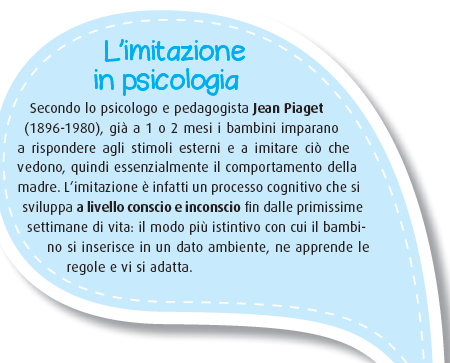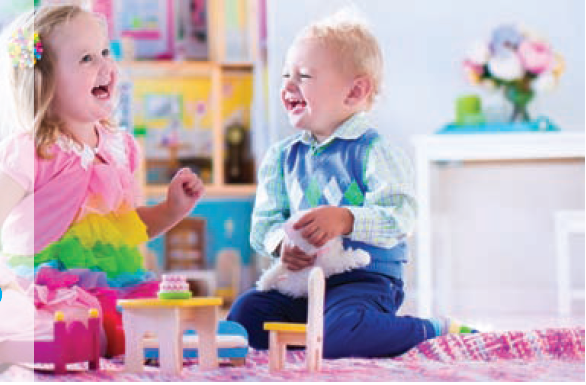 The age in which this playful modality develops goes from 18 to 36 months ; then, for many years the child does nothing but refine the technique, enrich the scenarios and reproduce new and increasingly complex situations.
Observing children while they play imitation games, you can understand a lot about the family and social environment in which they grow up, as well as the emotions, emotional needs and hardships they experience. For the child, these games are a tool for learning to behave 'as adults', assuming roles by definition the prerogative of adults, but also for expressing ailments and moods that the parent and educator must detect. In fact, the child will tend to replicate certain family or school dynamics, or on the contrary to make up for certain shortcomings by overturning - and therefore copying - reality on the contrary.
The age in which this playful modality develops goes from 18 to 36 months ; then, for many years the child does nothing but refine the technique, enrich the scenarios and reproduce new and increasingly complex situations.
Observing children while they play imitation games, you can understand a lot about the family and social environment in which they grow up, as well as the emotions, emotional needs and hardships they experience. For the child, these games are a tool for learning to behave 'as adults', assuming roles by definition the prerogative of adults, but also for expressing ailments and moods that the parent and educator must detect. In fact, the child will tend to replicate certain family or school dynamics, or on the contrary to make up for certain shortcomings by overturning - and therefore copying - reality on the contrary.

«Let's make sure I'm the mother and you'll be the little girl», «Let's make sure I drive the train and take everyone to the beach», "Let's make sure I'm the doctor and you're the sick one" ... They are many and nothing short of typical, during the 'childhood, the 'let's do that' with which children give the impetus to their imaginative games, based on innate processes of imitation and identification.
Similar games - from taking care of the dolls to cooking with saucepans, from the mini workshop to the tent in which to take refuge, from the supermarket checkout to the doctor's bag - re-propose the reality with which children frequently come into contact, at home and in other contexts .
The amazing thing is that you start playing by imitating from a very young age, taking the closest people as models - first of all the parents - according to the same mechanism of observation and copying that leads, for example, to babbling and then to pronouncing the first words.
 The age in which this playful modality develops goes from 18 to 36 months ; then, for many years the child does nothing but refine the technique, enrich the scenarios and reproduce new and increasingly complex situations.
Observing children while they play imitation games, you can understand a lot about the family and social environment in which they grow up, as well as the emotions, emotional needs and hardships they experience. For the child, these games are a tool for learning to behave 'as adults', assuming roles by definition the prerogative of adults, but also for expressing ailments and moods that the parent and educator must detect. In fact, the child will tend to replicate certain family or school dynamics, or on the contrary to make up for certain shortcomings by overturning - and therefore copying - reality on the contrary.
The age in which this playful modality develops goes from 18 to 36 months ; then, for many years the child does nothing but refine the technique, enrich the scenarios and reproduce new and increasingly complex situations.
Observing children while they play imitation games, you can understand a lot about the family and social environment in which they grow up, as well as the emotions, emotional needs and hardships they experience. For the child, these games are a tool for learning to behave 'as adults', assuming roles by definition the prerogative of adults, but also for expressing ailments and moods that the parent and educator must detect. In fact, the child will tend to replicate certain family or school dynamics, or on the contrary to make up for certain shortcomings by overturning - and therefore copying - reality on the contrary.
 The age in which this playful modality develops goes from 18 to 36 months ; then, for many years the child does nothing but refine the technique, enrich the scenarios and reproduce new and increasingly complex situations.
Observing children while they play imitation games, you can understand a lot about the family and social environment in which they grow up, as well as the emotions, emotional needs and hardships they experience. For the child, these games are a tool for learning to behave 'as adults', assuming roles by definition the prerogative of adults, but also for expressing ailments and moods that the parent and educator must detect. In fact, the child will tend to replicate certain family or school dynamics, or on the contrary to make up for certain shortcomings by overturning - and therefore copying - reality on the contrary.
The age in which this playful modality develops goes from 18 to 36 months ; then, for many years the child does nothing but refine the technique, enrich the scenarios and reproduce new and increasingly complex situations.
Observing children while they play imitation games, you can understand a lot about the family and social environment in which they grow up, as well as the emotions, emotional needs and hardships they experience. For the child, these games are a tool for learning to behave 'as adults', assuming roles by definition the prerogative of adults, but also for expressing ailments and moods that the parent and educator must detect. In fact, the child will tend to replicate certain family or school dynamics, or on the contrary to make up for certain shortcomings by overturning - and therefore copying - reality on the contrary.
Categorie del blog
Flyer


